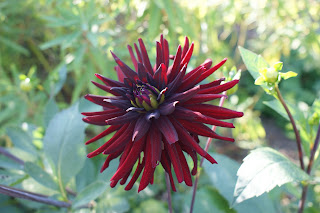Meet the famous albino squirrel of Dorking, which we happened across last month in one of its favourite haunts, the St Martins churchyard in the centre of the town. We were surprised by it, as albino squirrels are quite rare, and it wasn't all that famous when partner captured this image on his phone. But don't go rushing off to Dorking to visit the squirrel, as a couple of weeks later, BBC national TV reported that it had come to an unfortunate end under a car. We heard this sad news from Have I Got News For You, though it was originally covered in the national press. Paul Merton was very entertaining about it in his deadpan way... he's a local boy you know, from Morden, at the south end of Northern line.
Be not downhearted though. In our local paper the following week there was news of two more albino squirrels a few miles away in Carshalton, Surrey. Let's hope they're a bit more wary of the traffic.

Be not downhearted though. In our local paper the following week there was news of two more albino squirrels a few miles away in Carshalton, Surrey. Let's hope they're a bit more wary of the traffic.

Isn't this a gorgeous display of vegetables? I wish I could take the credit for them, but they came from uncle David's allotment. His sweetcorn did marvellously this season (you can see a beautiful pile of them at the back) but I'm also really jealous of that beautiful cabbage in the middle - maybe I'll try growing some next year.
Next, the last of the cornflowers, from the edges of a patch of meadowland, still bravely flowering (if a little the worse for wear) after the strong winds and pelting rain of the last 48 hours. They were quite luminous in the twilight, as only true blue can seem.
We found them up at the top of Cheam recreation ground, which is mostly football and rugby pitches, where it borders Nonsuch Park and has an amazing view across south London to the City and Canary Wharf beyond on a clear afternoon like today. Somebody (London Wildlife Trust? Local council? I've forgotten) planted up a gorgeous plot, about 30 metres square, with meadow and wild flowers, earlier this year and there were notices informing us that this was an experiment, and would be monitored for wild birds and other creatures. I first came across it in September when of course it was past its best, but still beautiful with poppies, cornflowers and sunflowers. l
and would be monitored for wild birds and other creatures. I first came across it in September when of course it was past its best, but still beautiful with poppies, cornflowers and sunflowers. l
One Sunday last month we walked past to find a flock of about two dozen bright green parakeets harvesting the sunflower seeds, a gorgeous sight; but I wonder if they were the wild life it was designed to attract? Not much left today to feed the smaller native seed eaters - goldfinches, greenfinches and the like.We found them up at the top of Cheam recreation ground, which is mostly football and rugby pitches, where it borders Nonsuch Park and has an amazing view across south London to the City and Canary Wharf beyond on a clear afternoon like today. Somebody (London Wildlife Trust? Local council? I've forgotten) planted up a gorgeous plot, about 30 metres square, with meadow and wild flowers, earlier this year and there were notices informing us that this was an experiment,
 and would be monitored for wild birds and other creatures. I first came across it in September when of course it was past its best, but still beautiful with poppies, cornflowers and sunflowers. l
and would be monitored for wild birds and other creatures. I first came across it in September when of course it was past its best, but still beautiful with poppies, cornflowers and sunflowers. lLastly, some English oaks in their autumn finery before the wind blows all the leaves away. Common enough round here, but they seem to be the last to change from green to copper then brown, so hold the final riches of autumn. They looked so warm and bright as the sun set late on Saturday afternoon. Looking at them feels almost like the physical need for summer sunshine, I stare and stare, greedily feeding on the warm bright colours, stoking up my inner fires before the cold grey winter really sets in.
hold the final riches of autumn. They looked so warm and bright as the sun set late on Saturday afternoon. Looking at them feels almost like the physical need for summer sunshine, I stare and stare, greedily feeding on the warm bright colours, stoking up my inner fires before the cold grey winter really sets in.
 hold the final riches of autumn. They looked so warm and bright as the sun set late on Saturday afternoon. Looking at them feels almost like the physical need for summer sunshine, I stare and stare, greedily feeding on the warm bright colours, stoking up my inner fires before the cold grey winter really sets in.
hold the final riches of autumn. They looked so warm and bright as the sun set late on Saturday afternoon. Looking at them feels almost like the physical need for summer sunshine, I stare and stare, greedily feeding on the warm bright colours, stoking up my inner fires before the cold grey winter really sets in.















































